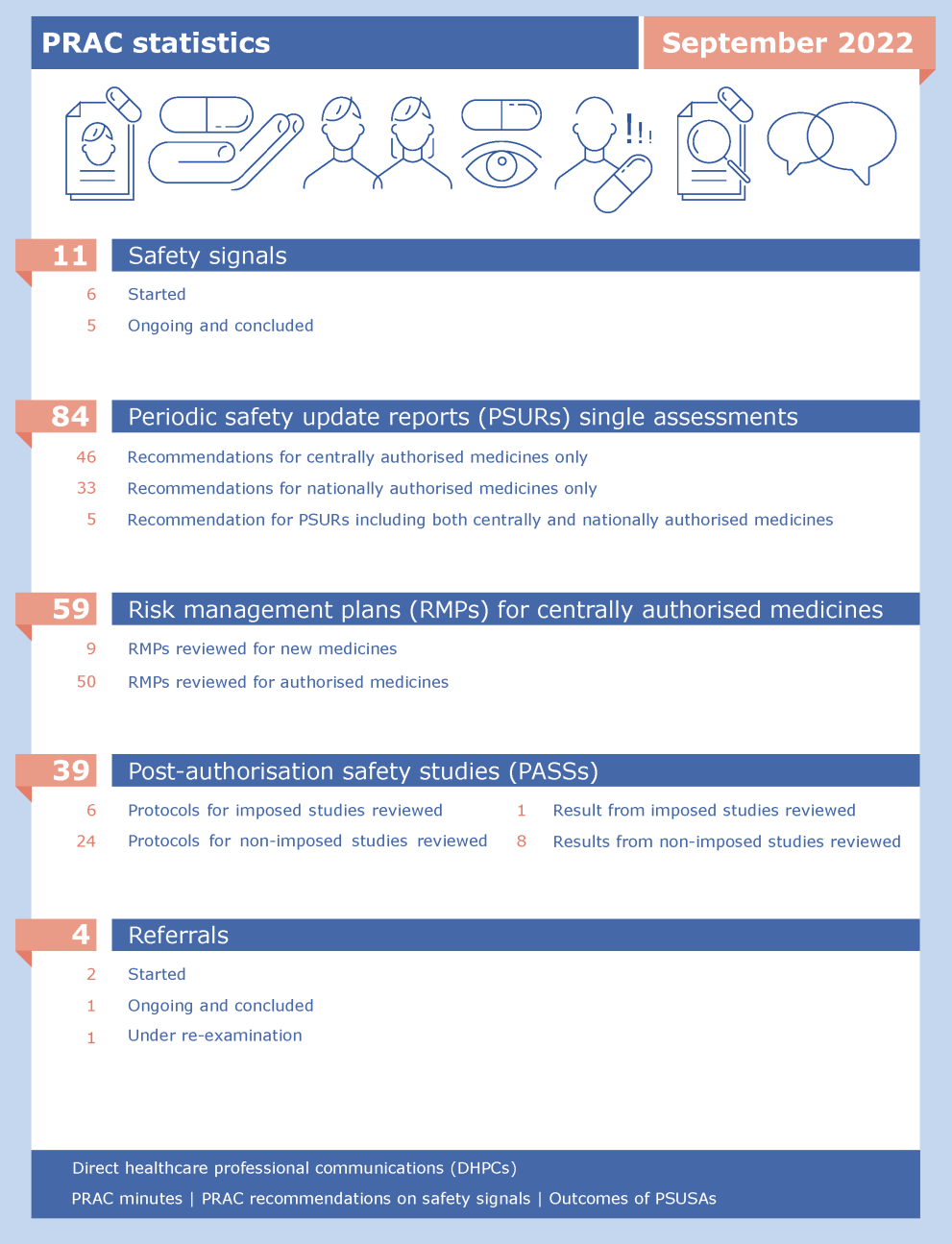Meeting highlights from the Pharmacovigilance Risk Assessment Committee (PRAC) 29 August – 1 September 2022
NewsHumanPharmacovigilanceReferrals
EMA’s safety committee (PRAC) has started a review of topiramate and the risk of neurodevelopmental disorders in children whose mothers were taking topiramate during pregnancy.
Topiramate is a medicine used in the European Union (EU) for the treatment of epilepsy, prevention of migraine and, in some countries, in combination with phentermine for body weight reduction.
Use of topiramate in pregnant women is known to increase the risk of birth defects. Women with epilepsy who are being treated with topiramate for their seizures are advised to avoid becoming pregnant, and to consult their doctor for advice if they wish to become pregnant. Topiramate must not be used to prevent migraine or control body weight in pregnant women and in women of childbearing potential (women able to have children) who are not using highly effective birth control methods (contraception).
The review was triggered by a recent study1 which suggested a possible increase in the risk of neurodevelopmental disorders, in particular autism spectrum disorders and intellectual disability, in children whose mothers were taking topiramate during pregnancy.
The PRAC started reviewing the study results as part of a safety signal assessment in July 2022. The committee will now conduct an in-depth review of the available data on the benefits and risks of topiramate use in pregnant women and women of childbearing potential in the approved indications. The committee will look in particular at the current risk minimisation measures and consider the need for additional measures to minimise the risks of topiramate use in these women.
While the review is ongoing, topiramate should continue to be used according to the authorised product information. Women should discuss any questions or concerns about their topiramate treatment with their doctor or pharmacist. Patients should not stop antiepileptic treatment before speaking with their doctor.
EMA will communicate the PRAC’s recommendation once the review has concluded.
More information is available in EMA’s public health communication.
EMA has started a review of medicines that contain pholcodine following concerns that their use may put people at risk of developing anaphylactic reactions (a sudden, severe and life-threatening allergic reaction) to certain medicines called neuromuscular blocking agents (NMBA).
Pholcodine is used to treat non-productive (dry) cough in adults and children and NMBAs are used in general anaesthesia to prevent spontaneous muscle movements to improve operating conditions.
The review was requested by the French medicines agency (ANSM) following preliminary results of a study carried out in France2. The results of the study suggested that taking pholcodine up to 12 months before general anaesthesia may increase the risk of having an NMBA-related anaphylactic reaction. Based on these results ANSM is considering, as a precautionary measure, to suspend the use of pholcodine-containing medicines in France.
The PRAC will now review the results of the ALPHO study together with all available data and assess their impact on the benefit-risk balance of pholcodine-containing medicines and issue a recommendation on whether their marketing authorisations should be maintained, varied, suspended or withdrawn across the EU.
More information is available in EMA’s public health communication.
1 Bjørk M, Zoega H, Leinonen MK, et al. Association of Prenatal Exposure to Antiseizure Medication With Risk of Autism and Intellectual Disability. JAMA Neurol. Published online May 31, 2022. doi:10.1001/jamaneurol.2022.1269.
2 Allergy to Neuromuscular Blocking Agents and Pholcodine Exposure (ALPHO) https://clinicaltrials.gov/ct2/show/NCT02250729

|
Procedure |
Status |
Update |
|---|---|---|
| Janus Kinase inhibitors (JAKi) – Article 20 Referral | Under evaluation | PRAC continued its assessment |
| Terlipressin-containing medicinal products | Under evaluation | PRAC continued its assessment |
| Amfepramone-containing medicinal products | Under re-evaluation | PRAC started re-examination |